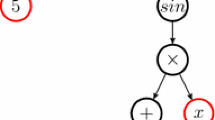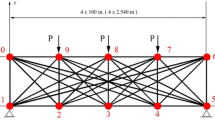Abstract
Truss shape and sizing optimization under frequency constraints is extremely useful when improving the dynamic performance of structures. However, coupling of two different types of design variables, nodal coordinates and cross-sectional areas, often lead to slow convergence or even divergence. Because shape and sizing variables coupled increase the number of design variables and the changes of shape and sizing variables are of widely different orders of magnitude. Otherwise, multiple frequency constraints often cause difficult dynamic sensitivity analysis. Thus optimal criteria and mathematical programming methods have considerable limitations on solving the problems because of needing complex dynamic sensitivity analysis and being easily trapped into the local optima. Genetic Algorithms (GAs) show great potentials to solve the truss shape and sizing optimization problems. Since GAs adopt global probabilistic population search techniques and require no gradient information. The improved genetic algorithms can effectively increase the solution quality. However, the serial GA is computationally expensive and is limited on gaining higher quality solutions. To solve the truss shape and sizing optimization problems with frequency constraints more effectively and efficiently, a Niche Hybrid Parallel Genetic Algorithm (NHPGA) is proposed to significantly reduce the computational cost and to further improve solution quality. The NHPGA is to blend the advantages of parallel computing, simplex search and genetic algorithm with niche technique. Several typical truss optimization examples demonstrate that NHPGA can significantly reduce computing time and attain higher quality solutions. It also suggests that the NHPGA provide a potential algorithm architecture, which effectively combines the robust and global search characteristics of genetic algorithm, strong exploitation ability of simplex search and computational speedup property of parallel computing.















Similar content being viewed by others
References
Cai Z, Wang Y (2006) A multiobjective optimization-based evolutionary algorithm for constrained optimization. IEEE Trans Evol Comput 10(6):658–676
Cantú-Paz E (1995) A summary of research on parallel genetic algorithms. Technical report, IlliGAL 95007, University of Illinois at Urbana-Champaign
Chen J, Che J et al (2001) A review on structural dynamic optimum design. Adv Mech 31(2):181–192 (in Chinese)
Goldberg DE (1989) Genetic algorithm in search, optimization and machine learning. Addison-Wesley, New York
Gordon V, Whitley D (1993) Serial and parallel genetic algorithms as function optimizers. In: Forrest S (ed) Proceedings of the fifth international conference on genetic algorithms. Morgan Kaufman, San Mateo, pp 177–183
Grandhi RV (1993) Structural optimization with frequency constraints—a review. J AIAA 31(12):2296–2303
Grandhi RV, Venkayya VB (1988) Structural optimization with frequency constraints. AIAA J 26(7):858–866
Hajela P (2002) Soft computing in multidisciplinary aerospace design—new directions for research. Prog Aerosp Sci 38:1–21
Hussain SJ, Ahmed G (2005) A comparative study and analysis of PVM and MPI for parallel and distributed systems. In: First international conference on information and communication technologies, 27–28 Aug 2005, pp 183–187
Li J, Mourelatos ZP (2009) Time-dependent reliability estimation for dynamic problems using a niching genetic algorithm. J Mech Des 31(7):071009-1–071009-13
Lim D, Ong Y, Jin Y, Sendhoff B, Lee B (2007) Efficient hierarchical parallel genetic algorithms using grid computing. Future Gener Comput Syst 23:658–670
Lin JH, Chen WY, Yu YS (1982) Structural optimization on genetrical configuration and element sizing with statical and dynamical constraints. Comput Struct 15(5):507–515
Lipson SL, Gwin LB (1977) The complex method applied to optimal truss configuration. Comput Struct 7:461–468
Meske R, Lauber B, Schnack E (2006) A new optimality criteria method for shape optimization of natural frequency problems. Struct Multidisc Optim 31:295–310
Michalewicz Z (1996) Genetic algorithms + Data structures = evolution programs. Springer, Heidelberg
Moshrefi-Torbati M, Keane AJ et al (2003) Passive vibration control of a satellite boom structure by geometric optimization using genetic algorithm. J Sound Vib 26(4):879–892
Munawar A, Wahib M, Munetomo M, Akama K (2008) A survey: genetic algorithms and the fast evolving world of parallel computing. In: The 10th IEEE international conference on high performance computing and communications, pp 897–902
Nelder JA, Mead R (1965) A simplex method for function minimization. Comput J 7:308–313
Papadrakakis M, Lagaros ND, Fragakis Y (2003) Parallel computational strategies for structural optimization. Int J Numer Methods Eng 58:1347–1380
Papadrakakis M, Lagaros ND, Tsompanakis Y, Plevris V (2001) Large scale structural optimization: computational methods and optimization algorithms. Arch Comput Meth Eng 8(3):239–301
P’etrowski A (1996) A clearing procedure as a niching method for genetic algorithms. In: Proc. 1996 IEEE int. conf. evolutionary computation. Nagoya, Japan, pp 798–803
Preuxa Ph, Talbib E-G (1999) Towards hybrid evolutionary algorithms. Int Trans Oper Res 6:557–570
Rozvany GIN, Bendsoe MP, Kirsh U (1995) Layout optimization pitfalls in topology optimization. Appl Mech Rev 48(2):41–117
Runarsson TP, Yao X (2000) Stochastic ranking for constrained evolutionary optimization. IEEE Trans Evol Comput 4(3):284–294
Sedaghati R, Suleman A, Tabarrok B (2002) Structural optimization with frequency constraints using the finite element force method. J AIAA 40(2):382–388
Sergeyev O, Mroz Z (2000) Sensitivity analysis and optimal design of 3D frame structures for stress and frequency constraints. Comput Struct 75(2):167–185
Skinner BT, Nguyen HT, Liu DK (2007) Hybrid optimisation method using PGA and SQP algorithm. In: Proceedings of the 2007 IEEE symposium on foundations of computational intelligence (FOCI 2007), pp 73–80
Smith S (1998) The simplex method and evolutionary algorithms. In: Proceedings of the 1998 IEEE international conference on evolutionary computation. Pricataway, pp 799–804
Srinivas M, Patnaik LM (1994) Adaptive probabilities of crossover and mutation in genetic algorithms. IEEE Trans Syst Man Cybern 24(4):656–667
Wang D, Zhang WH, Jiang JS (2004) Truss optimization on shape and sizing with frequency constraints. AIAA J 42(3):622–630
Wei L, Zhao M, Wu G, Meng G (2005) Truss optimization on shape and sizing with frequency constraints based on genetic algorithm. Comput Mech 35(5):361–368
Zdenˇek K (2004) Parallel genetic algorithms: advances, computing trends, applications and perspectives. In: Proceedings of the 18th international parallel and distributed processing symposium (IPDPS’04)
Acknowledgements
The authors sincerely thank the anonymous reviewers for their constructive and helpful comments and suggestions.
This work was supported by National Science Foundation of China (Grant No. 50605010).
Author information
Authors and Affiliations
Corresponding author
Rights and permissions
About this article
Cite this article
Wei, L., Tang, T., Xie, X. et al. Truss optimization on shape and sizing with frequency constraints based on parallel genetic algorithm. Struct Multidisc Optim 43, 665–682 (2011). https://doi.org/10.1007/s00158-010-0600-0
Received:
Revised:
Accepted:
Published:
Issue Date:
DOI: https://doi.org/10.1007/s00158-010-0600-0




